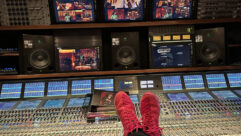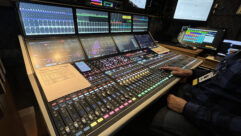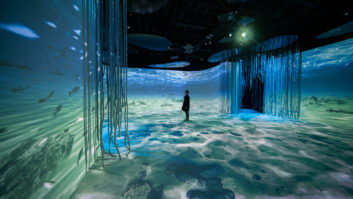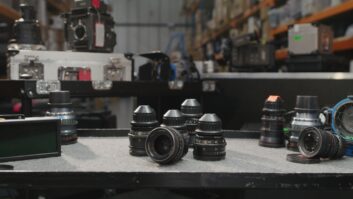IT’S IN THE MIX
Jan 1, 2002 12:00 PM,
PETER H. PUTMAN, CTS
THEY STARTED OUT AS BIG, BULKY BOXES, NEEDING lots of cabling. Over time, their useful range of display resolutions increased. Advances in chip technology made them smaller, and digital interfaces became available. Further enhancements allowed them to switch seamlessly between signal sources, and some models have become small enough to fit in the average conference room or classroom.
It sounds like I’m talking about front projectors, but I’m not. What I am describing is a class of products known as seamless video/RGB scaler/switchers: devices that let you switch, dissolve, cut or fade between interlaced and progressive-scan video sources. These products don’t get quite as much press as hot technologies like plasma or IP connectivity, but they have evolved at such a rapid rate that you may see them incorporated directly into electronic displays in the near future.
These devices are all the rage for large-group presentations and represent prayers finally answered for staging and rental companies, not to mention meeting producers. Now, the interest among manufacturers is getting seamless scaler/switchers into conference rooms, classrooms and auditoriums (and you will see versions with IP addressing and DVI inputs).
In a world with a bewildering array of signal formats and scan rates, these products have made it possible to ignore source formats and instead simply connect all the different sources. Then you can select the desired output resolution and image refresh rate, and start showing your stuff.
WHY THESE THINGS ARE SO NEEDFUL
ON THE SURFACE, video/RGB mixing and switching doesn’t appear to be all that complicated. But there’s more than meets the eye here. Consider the ubiquitous desktop PC, which sends a 4- or 5-wire progressive-scan signal to its associated computer display monitor. In the 4-wire system, those signals are red (R), green (G) and blue (B), plus composite sync (Cs). In a 5-wire system, the composite sync is broken into separate horizontal (H) and vertical (V) sync pulses.
In contrast, interlaced video can travel in three flavors: down a single wire as a composite NTSC signal (with luminance, chrominance and sync all mixed together), down two wires as Y-C (luminance and chrominance separated), or down three wires as YCbCr (luminance and two color difference signals). So right off the bat, we not only have a mismatch in the number of cables between video and RGB, we also have two different ways of scanning the image.
Throw in DTV signals, and the picture gets even muddier. 480i DTV remains interlaced, as does 1080i. Both use a 3-wire system with luminance and two color difference channels, identified as YPbPr. The 480p and 720p signals are at least progressive-scan formats, but also employ the YPbPr scheme. There’s no composite or S-video version of DTV.
While it’s true that some set-top DTV receivers can output all ATSC formats as RGBS or RGBHV, the RGB display device must be able to support the ATSC tri-level sync standard, or it will be unable to stay locked up on the image for very long. In short, there’s a real mish-mosh of video cable, sync and scan formats in today’s system integration world, and it’s not likely to get any easier.
A QUICK TIMELINE
UNTIL RECENTLY, IT was not practical to develop a black box that could easily translate from one of these formats to another. For one thing, any mixing would have to be done in the progressive-scan domain, to match the optimum image-quality requirements of large-screen displays. For another, it would take top-notch decoding of any video sources to prevent dot crawl and color moire in the final images.
But thanks to free-falling costs of developing and producing Application Specific Integrated Circuits, it became possible to manufacture circuits to convert interlaced video to progressive-scan video in the early 1990s. These line doublers, as they were called, were first developed by Faroudja Labs. In effect, they turned any composite or component video source into a VGA computer signal.
Subsequent developments by Faroudja and other manufacturers resulted in devices that could quadruple the number of scan lines in the converted images by interpolating new picture scan lines from existing ones, inventing, in effect, new picture elements that never existed. These line quadruplers doubled the vertical resolution of the image, necessitating electronic displays with more available pixels.
Not bad, but the world was moving away from raster imaging to flat-matrix imaging. So, the next step had to be a native rate scaler, or a device that would convert video sources to a specific RGB output resolution not tied to any video standard, like SVGA (800×600 pixels), XGA (1024×768 pixels), and other resolutions including 1024×1024, 1365×768 and 1365×1024 pixels.
Thus was born the RGB seamless switcher, first seen in rental-and-staging mode as Folsom Research’s Variable Format Converter and Analog Way’s Graphic Switcher. These two companies have since been joined by Extron, FSR, RGB Spectrum, InLine and Kramer Electronics in offering these wonder boxes to the large-venue marketplace.
THE BASIC FUNCTIONS
WHILE INDIVIDUAL designs vary, most of these seamless switchers provide five to eight inputs that can be anything you like, from composite NTSC to 1280×1024 SXGA RGB and even 480p/720p HDTV; and offer one, two or three up-converted outputs at a standard RGB pixel resolution of your choice. Internally, all interlaced sources are decoded (composite) and then converted from the YUV color space to RGB. Additional circuitry provides motion compensation, noise reduction and 3:2 pulldown correction for interlaced video sources. In this way, 480i video becomes RGB 480p video with progressive scan.
The next step is to scale — or resize — the 480p material to the desired output resolution, such as 1024 by 768 pixels. Other RGB sources that are already progressive are also similarly converted, using digital scaling techniques that interpolate additional pixels (scaling up) or compress and decimate pixels (scaling down). Finally, the up-converted sources are mixed or switched from one buffer to another. Note that all mixing, dissolve, wipe and iris effects are done at the final output resolution, which requires quite a bit of video RAM to pull off. Sync correction and genlock are also introduced here, so that the final image sent to the display has no “hits” or glitches.
Systems integrators know a good thing when they see it, so a clamor went up for smaller, rack-mountable conference room scalers. And guess what: Manufacturers are listening.
OPTIONS ON THE MARKET
FOLSOM RESEARCH brought out the PresentationPro compact seamless switcher at NAB 2001. It occupies one rack unit but incorporates full mixing/switching of interlaced and progressive signal sources. The output can be set to four different computer standards from VGA to SXGA, and there’s also an audio follow switcher and line-level/microphone mixer. Motion adaptive de-interlacing is used for improved video quality from film material.
Analog Way invented the classic seamless switcher, as well as the name. Its current conference-room offering is the Smart Fade, a 7-input, single-output seamless switcher that assigns five input jacks to interlaced video in composite, Y/C or component formats; and two other jacks to RGB signals up to 1600×1200 resolution. Supported output formats include plasma standards as 852×480 and 1280×768, plus standard computer resolutions to 1280×1024. Stereo audio follow is standard.
Analog Way also has a basic seamless switcher (no mixing allowed), the Smart Cut 2. It provides two computer and five video inputs with audio follow, and converts all signals to RGB rates from VGA to SXGA.
Extron Electronics dipped into its barrel of ASICs and came up with the ISS 108 and ISS 408 integration seamless switchers. Both offer eight inputs (any interlaced or progressive source), dual buffered outputs on 15-pin jacks and BNCs, and a preview output. The ISS 108 supports 17 different output rates to 1024 by 768, while the ISS 408 adds HDTV compatibility and will scale up to 1365 by 1024 as well as 480p, 720p, 1080p and 1080i. Both incorporate automatic 3:2 pulldown detection, audio cross-fading, and feature five test patterns for display setup.
FSR’s Compass seamless scaler/switcher is a 1RU design with seven inputs and one output (no preview bus). It uses programmable effects and accepts everything from composite to 480p and 720p HDTV and up to 1600×1200 RGB sources. Maximum output resolution is 1365 by 1024, and some 50-inch plasma resolutions (1280 by 768 and 1365 by 768) are supported.
Where there’s a demand for an interface, there’s Kramer Electronics. Kramer’s VP-770DS, announced at CEDIA Expo, provides eight video and four audio inputs. It accepts interlaced and progressive-scan signals from NTSC to YPbPr and RGB 480p, 720p and 1080i, and converts them to any RGB output to 1600 by 1200 and also 480p, 720p and 1080i RGB.
It should be no surprise that InLine also decided to join the switcher/scaler fray with the IN1408. This standalone box (also rack-mountable) doesn’t mix signals, but will let you switch effortlessly between up to eight different interlaced video sources and four RGB sources (maximum eight inputs at any time). In addition, the fifth and sixth inputs support DVI. Output signals are scaled from 640 by 480 to 1600 by 1200, and there’s also a DVI output.
If there was ever a product category that can be called “set it and forget it,” this is it. But the fun isn’t over yet. The 2RU and 1RU chassis are nice and small, but why not get rid of ’em entirely? In the future, you will likely see all the functions in a seamless scaler/switcher integrated into ASICs to be imbedded into plasma and LCD monitors, and LCD, DLP and LCoS (Liquid Crystal on Silicon) front and rear projectors. Some sort of digital interface would be used to control the actual functions, probably through an IP or similar interface. For that matter, we may move to all-digital interfaces and eliminate all the different analog cable configurations. (InLine was one of the first to support DVI, but it won’t be the last.) Indeed, several manufacturers now provide card slots for development of seamless switcher and scaler products by the aftermarket.
Notable examples include Pioneer’s new 50-inch PDP-503 FlexPlasma, and numerous large-venue/installation front LCD/DLP projectors. Don’t be surprised if you eventually see similar functions appearing in consumer-grade RPTVs and plasma monitors. Could this be the next incredible shrinking product? Don’t bet against it…
Peter H. Putman owns PHP Communications, Doylestown, Pennsylvania. He is the author of The Toastmasters Guide to Audiovisual Presentations and reviews large-screen video displays, scalers and computer/video interfaces.










